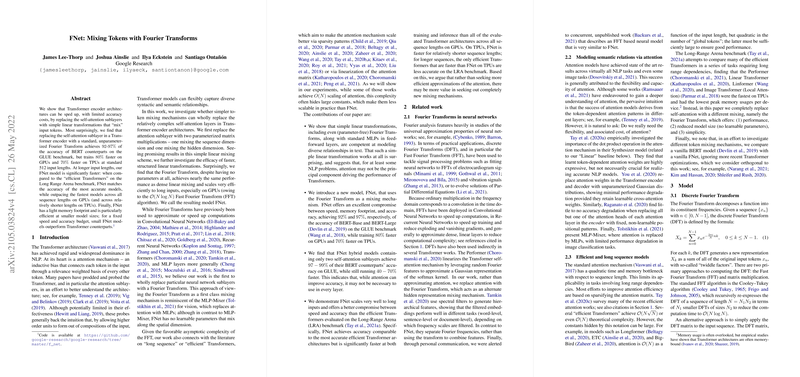An Overview of "FNet: Mixing Tokens with Fourier Transforms"
The paper "FNet: Mixing Tokens with Fourier Transforms" by James Lee-Thorp and colleagues from Google Research presents a novel approach to accelerate Transformer encoder architectures. The research focuses on replacing the self-attention sublayers typically found in Transformer encoders with linear transformations and, more specifically, with the Discrete Fourier Transform (DFT). The paper offers a substantial contribution to the field of NLP models by introducing the FNet architecture, which provides a remarkable trade-off between computational efficiency and accuracy.
Core Innovation
At the heart of this work lies the innovative idea of using Fourier Transforms as a substitute for the self-attention mechanism. Traditionally, self-attention layers are pivotal in capturing syntactic and semantic relationships across tokens in a sequence. However, they also impose considerable computational overhead, particularly for long-sequence processing, due to their quadratic complexity with respect to sequence length.
The authors propose a simplified model where the Fourier Transform serves as a token mixing mechanism, devoid of parameterization, thereby achieving linear complexity. Their experiments reveal that, for some NLP tasks, the self-attention mechanism may not be solely responsible for the efficacy seen in comprehensive models like BERT. The FNet model demonstrates that Fourier Transforms can capture token interdependencies almost as effectively, achieving 92-97% GLUE benchmark accuracy of BERT counterparts while drastically reducing the training time.
Evaluation and Results
Empirical evaluations in the paper highlight FNet's performance under various benchmarks and configurations:
- Efficiency with Long Sequences: When assessed on the Long Range Arena (LRA) benchmark designed to test long-sequence processing capabilities, the FNet model outperforms the fastest models and maintains comparable accuracy to the most precise ones. Specifically, it trains 80% faster on GPUs and 70% faster on TPUs for standard input lengths, validating the model's operational efficiency.
- GLUE Benchmark Accuracy: FNet models achieve significant performance, reaching close to BERT's accuracy levels on GLUE tasks, such as SST-2, CoLA, and MRPC, but with reduced computational demands, which is a critical achievement for deploying NLP models in resource-constrained environments.
- Parameter Efficiency: With fewer (or no) learnable parameters in its mixing mechanism, FNet also saves substantial memory resources compared to canonical Transformer architectures, which is advantageous for scaling and deploying models in production environments with limited computational budgets.
Practical and Theoretical Implications
The practical implications of FNet are vast, particularly in scenarios where computational speed and resource efficiency are paramount. The architecture offers a valuable alternative to traditional attention-based models, presenting a pathway towards creating more efficient NLP models without severely compromising on accuracy. Theoretically, this work prompts a reevaluation of attention mechanisms' role and importance in neural architectures for NLP, suggesting that alternative non-learnable mechanisms may suffice or even excel in certain tasks.
Future Directions
In light of these findings, several avenues for future research are apparent. First, there is potential to further explore other linear transformations or hybrid models that synergize FNet with attention mechanisms to strike optimal accuracy-speed balances. Additionally, adapting the FNet concept to decoder architectures and cross-attention mechanisms in encoder-decoder models remains an open area for exploration. Future research could also focus on domain-specific applications of FNet, such as in computationally intensive environments like real-time translation services or large-scale information retrieval systems.
In summation, FNet offers a compelling insight into efficient token mixing strategies with the Fourier Transform, adding a valuable perspective to the ongoing discourse on scalability and performance in NLP model design.
